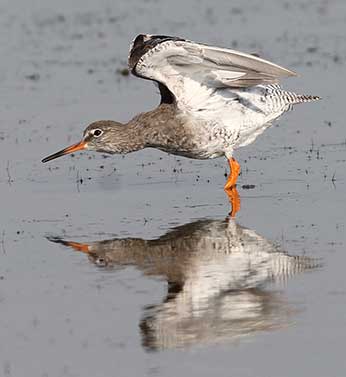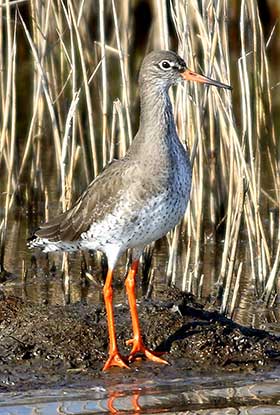Redshank (Tringa tetanus)
When: Late-March or April to late-July
How many: Relatively small numbers

Often conspicuous birds of the New Forest wetlands, redshanks are spring and summer visitors to the New Forest, arriving from the coast in April, and usually leaving by July.
Redshanks are long-legged creatures, slender, graceful and upstanding, but of deceptively modest size, their length not much bigger than that of a blackbird.
Long, reddy-orange legs give the redshank its common name, whilst the bill is lengthy, straight and also reddy coloured.
Redshank plumage, though, is of more subdued hue - essentially brown above, and white with darker mottling below.
Then in typically fast, erratic flight, white inner trailing wing edges and rump are unmistakable. And if that is not enough, the redshank's agitated, far-carrying cries - tlu-leu-leu - should clinch identification.
With good reason, redshanks were once known as ‘yelpers of the marsh’, for the slightest hint of provocation – the threatening outline of a distant carrion crow, a dog or walker on the horizon, even a New Forest pony straying a bit too close for comfort - will usually bring the same noisy, babbling redshank response.
Many redshanks apparently pair for life, and arrive together in the New Forest. Males use early morning, stiff winged display flights to impress the female in their lives, and also to send a signal of aggression to other males.
But redshanks are essentially shy, wary creatures that choose to breed in the New Forest’s quieter places, places little visited by people and their dogs, and always where the ground is wet and largely inaccessible to land-based predators.

Predatory crows, however, habitually pose a threat, hanging around the breeding grounds, waiting patiently for adult redshanks to leave the nest unguarded.
Redshank nests are, though, often incredibly well concealed, no more than shallow depressions lined with grass stems and leaves beside a tussock or other protective vegetation. Overhanging, intertwined leaves and stems often form a canopy, with access through an entrance at the side.
Four eggs are normally laid. Young redshanks hatch after around 24 days, complete with a covering of down, and are immediately mobile, fledging after a further 25-35 days.
The number of breeding redshanks in the New Forest has recently declined. The most recent redshank survey, in 2004 by the RSPB, showed an estimated 42 pairs compared to 55-56 pairs in 1994, a decline of 22-26%. This is less than half that of the closely related curlew (99 pairs) and snipe (111).
Potential causes are changes in habitat quality and increasing disturbance of redshanks by walkers, dogs and horse riders.
Elsewhere in much of Hampshire and the south of England, breeding redshanks have shown even more significant recent declines. The New Forest redshank population, then, is of particular importance to the species.
John Wise provided an interesting insight into the perceived status of New Forest redshanks in the middle years of the 19th century, saying: ‘This bird is certainly a resident throughout the year. I have repeatedly put it up during the autumn in some of the swamps near Stoney Cross, more especially in the evening, when it will hover round and round, just keeping overhead, not unlike a pewit. Several nests are yearly taken…….’
Whether Wise was mistaken, or whether redshanks really were year-round residents, is now, of course, difficult to judge.
References:
The Shell Guide to the Birds of Britain and Ireland: James Ferguson-Lees, Ian Willis and J.T.R. Sharrock
Hampshire Bird Reports: Hampshire Ornithological Society
The Birds of the Western Palearctic, Concise Edition: D.W. Snow and C.M. Perrins
The New Forest: Its History and Scenery: John R. Wise.
New Forest Breeding Waders Survey 2004: A Survey of the Breeding Waders in the New Forest Valley Mires: R.D. Goater, C. Temple and A. Thomas
More links
Other related links
Search this site

Sadly, 58 animals were killed - 35 ponies, 13 cows, 8 donkeys and 2 sheep, whilst a further 32 were injured - 3 pigs, 9 donkeys, 11 cows and 9 ponies.
(Forty-three accidents occurred in daylight, 15 at twilight and 101 in the dark. Twenty-seven accidents were not reported by the driver involved).
Here's just one horrific example - Three donkeys killed in collision with van at notorious New Forest blackspot (Advertiser and Times)

